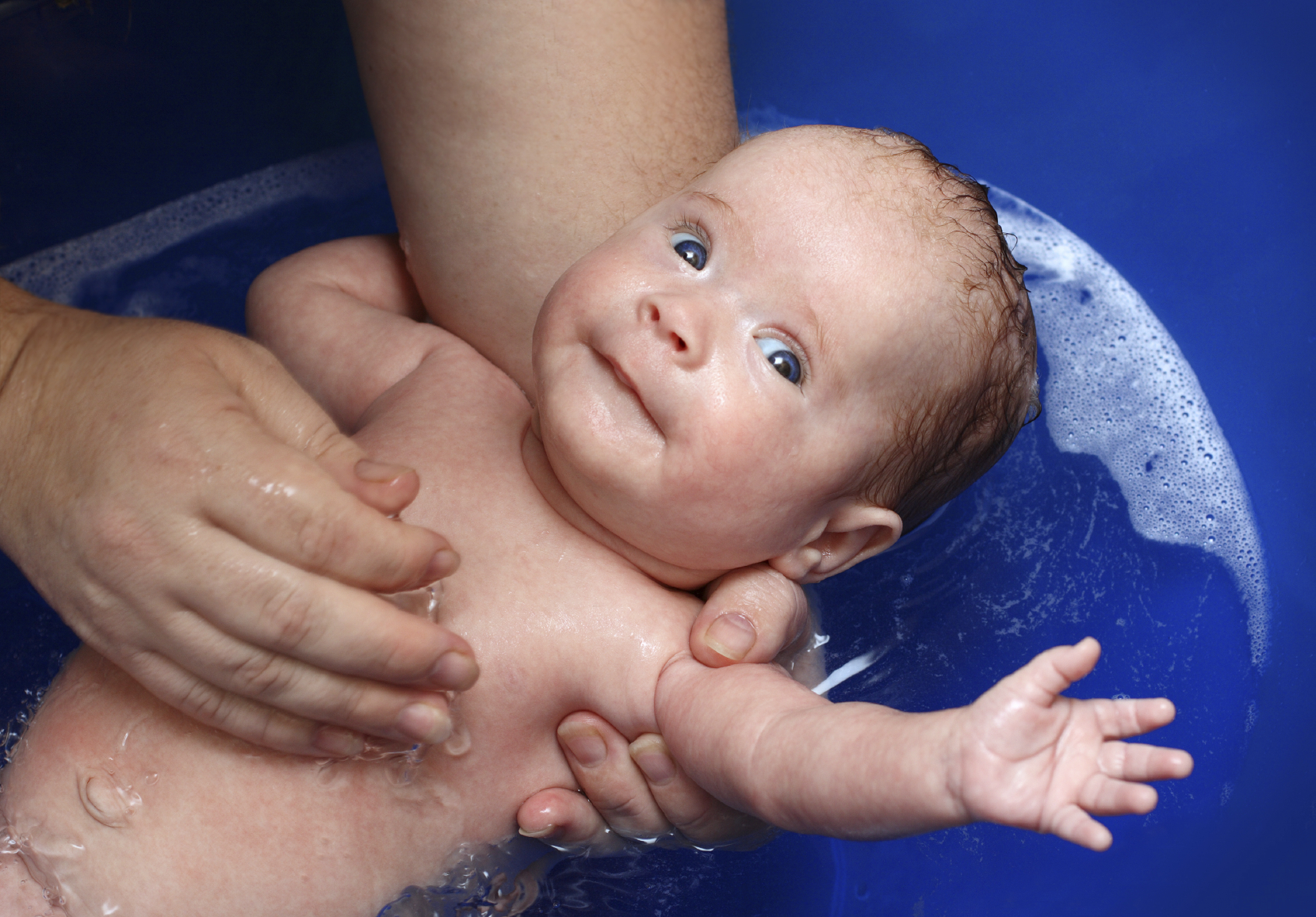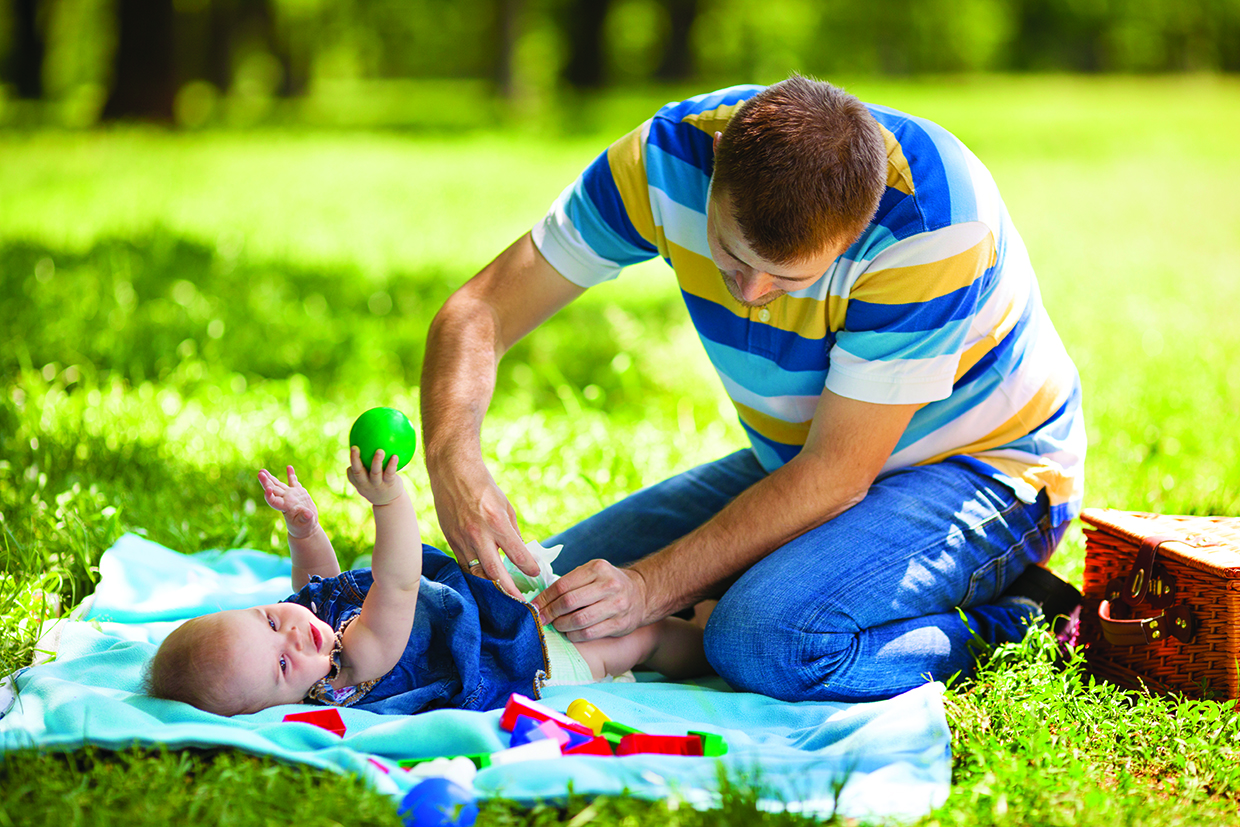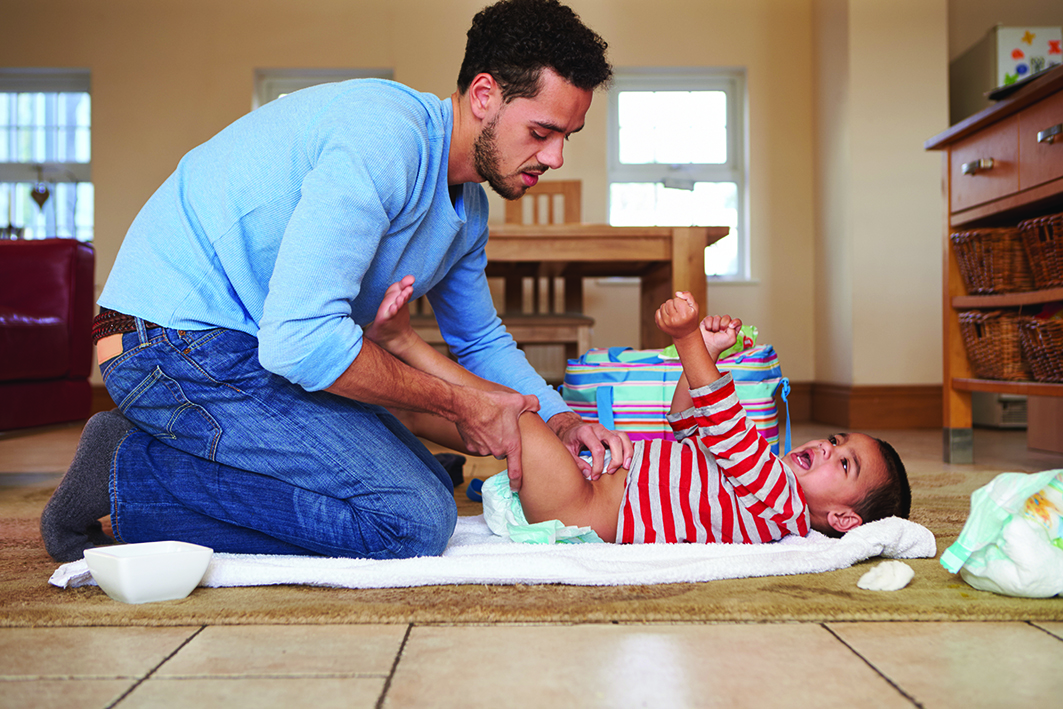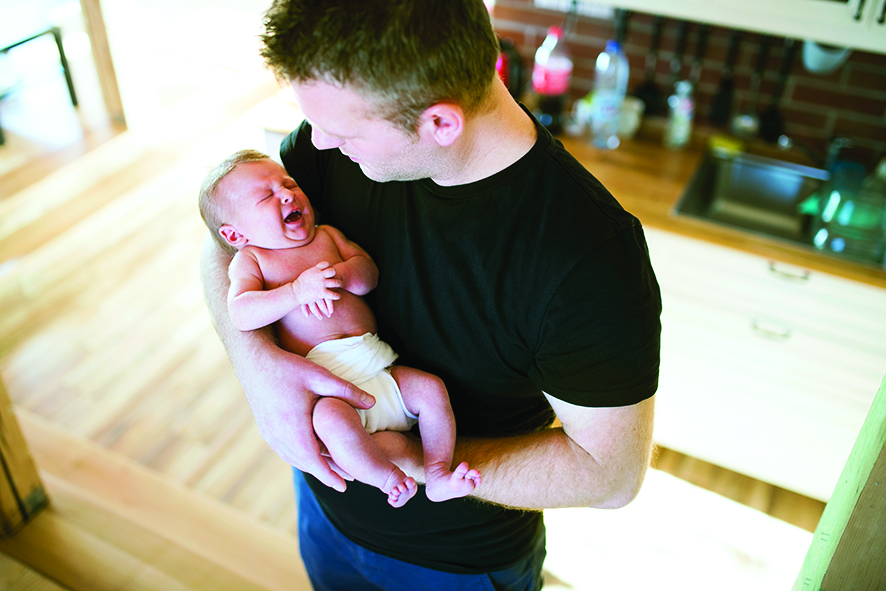
Ask DadPad, Key Content, Parenting Advice
Ask DadPad: How do I care for my baby?
Posted on 19th June 2020
As a new dad, one of your biggest concerns might be how you are going to care for your newborn baby. Like most things in life, it’s actually a lot easier than you think, and will definitely get better very quickly with practice.
Washing and bathing your baby
One of the scariest things for any new parent is going to be washing and bathing your baby. After all, babies are small, apparently fragile and – when put into water – become really quite slippery! The first thing to know is that you don’t need to give your baby a full bath every day, but – if she enjoys it – you can.
However, you should try and give her face, neck, hands and bottom a daily wash. You won’t really need any special equipment or lotions to do this – just a bowl of warm water, some cotton wool and a towel.
If you are going to bath your baby, you shouldn’t use anything other than water in her bath for the first month, as babies have very thin, delicate skin. Remember that the bath water needs to be warm, but not hot – for safety reasons, you should always put cold water in the bath first, and then add hot water to warm it. Mix the water thoroughly, to avoid there being any hot patches, and use your elbow or wrist to check that the temperature is ok.
Probably the safest place to wash, dry and/or sort baby for their bath is on her changing mat, which should always be placed on the floor. Whether it’s a wash or a bath, you should always start by stripping baby down to her nappy, before dampening a piece of cotton wool into the water and using it to wash her face. Wipe gently around baby’s eyes, and use a fresh piece of cotton wool for each eye to avoid transferring any stickiness or infection. You should also clean around (but not inside) her ears, neck and hands.
You now need to remove baby’s nappy and clean her bottom and genital area with more clean, damp cotton wool. If baby is having a bath, you now need to pick her up and carefully lower her into the water. The easiest way to do this is to use one hand to gently but firmly hold her upper arm, whilst also supporting her neck and shoulders. You can then use your free hand to gently swish – but not splash – the water around her. You can also gently wash baby’s hair in the water at this time.

After her bath, bring her out onto a towel and lie her back down onto her changing mat. Take care to ensure that all her little skin folds and creases have been dried well, before putting on a fresh nappy and clean clothes.
Key dos and don’ts when washing and bathing baby:
DO:
- Place the changing mat on the floor, so baby is safe, and can’t fall
- Make sure that the room is warm, so baby doesn’t get cold
- Use a separate piece of clean cotton wool for each eye, and each area of the baby’s body
- Talk or sing gently to baby all the way through the wash or bath – this will help both of you feel more relaxed and will also help baby become more familiar with your voice
- When filling baby’s bath with water, always put the cold water in first, then top up with hot
DON’T:
- Clean inside baby’s ears, or use a cotton bud to clean inside baby’s ears
- Wash or bath baby straight after a feed, or when they’re hungry or tired
- Leave baby alone in the bath, even for just a second – babies can drown in just a few centimetres of water
- Use a baby bath seat as a safety device. They should only ever be used with adult supervision, as babies can wriggle free and topple over into the water
- Fill baby’s bath with too much water – you’ll want to be able to keep her head clear of the water
Nappy change
Changing a nappy is also something that lots of new parents are quite nervous about, but you will soon become used to the sights, sounds and smells that your baby produces!
In the early days, some nappies can be quite spectacular and (to the untrained eye) rather scary – but observing the changes and knowing what to look for can actually help you tell whether or not your baby is feeding well. We’ve put a link at the bottom of the page to a page on the NCT website which sets out some really useful photos and also includes a link to an information sheet, to help you better understand the situation.
Taking the lead on nappy changing is actually a really useful and helpful thing for dad to do, especially if mum is breastfeeding. It will give you the opportunity to have regular one-to-one time, close to your baby, so that you can gain confidence in handling her but also get to know each other, and build a strong attachment. It also allows mum to have a bit more of a rest in between feeds.
As with washing and bathing baby, the key tip is to be prepared before you get started. First of all, you’ll need something to lie baby on. Ideally, this will be a waterproof changing mat – for obvious reasons! – which you’ve placed on the floor, but you might sometimes need to improvise if you are out and about and/or you have an emergency. Most public toilets will have a baby change area (which should be accessible to dad as well as mum), but these are often on a table-top surface or a baby change unit. You need to be extra careful in these situations – keep a hand on baby at all times to ensure that she cannot fall, even if she’s been strapped onto the unit.

You’ll also need something to clean baby with. With a newborn baby, it’s best to use just cotton wool and warm water, to protect her delicate skin, but you might also want to use wet wipes. Make sure that you have a good supply – it’s best to be over-, rather than under-prepared!
You’ll need to have a clean nappy to hand, plus nappy rash cream (if required) and something to put the dirty nappy in. You might also want to have some spare clothes for baby nearby… just in case.
It’s a good idea, when you’re new to changing, to have the new nappy opened up and laid out the right way around. Disposable nappies are not overly-complicated, but you might want to practice taking them on and off on a teddy bear etc first, so that you feel a bit more confident when doing it all for real.
When you’re ready and have made sure that your hands are clean, you can get started by lying baby onto her changing mat. A good tip is to talk to baby all the way through the operation – it could be something as simple as talking her through what you are doing. This will help keep you calm and focused, and will hopefully entertain baby. Making regular eye contact with each other – especially as baby gets a little older – will also help you to bond with one another.
In terms of the practicalities, the first thing you need is to gain access to the nappy, so all clothing that covers her bottom half will need to be removed. It’s also a good idea to move her vest and top a little bit up and away from her bottom, to minimise the chance of getting them dirty or wet.
Undo her nappy and open it up – watch out, though, as the cold air hitting the skin can sometimes cause baby to wee! Gently holding baby’s ankles with one hand, lift baby’s bottom up a little so that you can slide the nappy out from under her, using it to gently wipe away the worst of the poo or wee as you do so. Move the nappy to one side.
You now want to clean baby’s bottom – and sometimes you might also need to clean further up her back. Always have a good check as you never know what might be lurking! You will use your damp cotton wool or wet wipes for this. A couple of key bits of advice when cleaning are that, for girls, you should always clean from front to back and, for boys, you should never attempt to pull back his foreskin.
If baby has a sore bottom, you should gently put some nappy rash cream on the whole area that the nappy will cover. You should also let baby have a little kick around whilst lying on the mat with her nappy off. This will give her skin the chance to breathe. If you’re worried about potential mess, pop a little towel under her bottom.
To put the clean nappy on, open it up and slide it under baby’s bottom, using the same ankle-lifting technique from earlier. Gently lower her legs back down and fasten the nappy up. Getting the nappy fastened well can take practice – you don’t want it too tight, as this will be uncomfortable for her, but you also don’t want it too loose that it might fall off and/or allow its contents to escape!
Once she’s changed and dressed, you can have a quick cuddle together (although you will probably want to give your hands a quick wipe first). Make sure that she’s somewhere safe whilst you tidy up. You’ll need to put the dirty nappy into a nappy sack, which you can then tie up and put into the bin. Do be careful with nappy sacks, though – never leave them lying around or where baby could grab them as they are plastic bags and therefore a choking or suffocation hazard. You should then give your hands a good wash.
That probably all sounds really complicated, but – once you’ve practiced a few times – you’ll find that it becomes very easy. And, yes, there will be the odd nappy that requires you to abandon the wet wipes and the changing mat, strip baby off and give her a quick bath! However, these happen to everyone and, as horrible as they are at the time, they will soon become part of your parenthood survival stories!

Key dos and don’ts when changing baby’s nappy:
DO:
- Place the changing mat on the floor, so baby is safe, and can’t fall
- Wash your hands thoroughly both before and after changing baby
- Make sure that you always clean a baby girl’s bottom from back to front, to avoid causing infection
- Be really careful to wipe baby clean in all of his/her skin folds – check carefully (especially up their back) for hidden poo, to ensure that nothing gets left behind
DON’T:
- Leave baby unattended or turn your back when changing her on a high surface (e.g. when out and about and it’s not possible to change her on the floor)
- Leave nappy bags (empty or full) where baby could grab one – she could easily choke or suffocate if it ends up in her mouth
- Try and pull back the foreskin on a baby boy
Crying
Perhaps the hardest thing when caring for your baby is to learn to cope with her crying. Remember, though, that all babies cry for a reason – it’s their way of communicating, and a pretty successful way of getting your attention! Try not to panic or worry that you’ve done something wrong; instead, try and work out what she’s trying to tell you. Obviously, you can’t ask her but you can look for clues, and also try things, to see what works.
Some key things to check for with a crying baby are:
- HUNGER – how long is it since baby had a feed? Is she demonstrating any feeding cues (things like mouth opening, lip licking and hand sucking)?
- UNCOMFORTABLE – does baby need her nappy changed? This is where you get to ‘enjoy’ that infamous parental activity: the ‘bum sniff’ – we’ve all done it! With both fabric and disposable nappies, you can also get a good idea from their weight whether they’ve been weed in.
- TIRED – does baby need a nap?
All of these common reasons for crying are easily remedied, and hopefully this will stop the crying. Other reasons to look and listen out for, though, include:
- in pain (you’ll know this cry when you hear it!);
- feeling poorly (e.g. a tummy ache);
- feeling really poorly (as with the cry of pain, you should be able to spot this one without any doubt. Always act on your instinct if baby’s cry is noticeably weak, or will not stop, or is combined with other symptoms that are not normal for her);
- feeling frightened (new sights and sounds might easily startle baby); or
- just a bit unsettled and in need of a cuddle with dad.
Although, to start with, all cries might sound the same, you will soon find – and especially as you get to know your baby and her individual personality – that you become better at working out what she needs.
However, on some occasions, no matter how hard you try, you might feel as though nothing is helping. Depending on your circumstances, it might be an idea to put her in her pram or the sling and go for a walk, or strap her in her car seat and go for a drive. Often, the change of scenery or the soothing motion can help to settle her down. You could also try singing to her (she won’t care whether you’re any ‘good’ or not – she will just enjoy hearing your voice), play her some soothing music, cuddle her in different positions, or gently rock her in your arms. As you become more experienced as a dad, you will get to know what works best for your baby.

Coping with crying
If you ever feel yourself getting angry, frustrated or cross with baby, however, you need to take positive steps to calm down. Don’t ever take out your anger on your baby – shouting at her will only upset her more, and shaking or rough-handling can cause real, serious and irreparable damage to her body and brain, and even death. Instead, place baby somewhere where you know she is safe – such as in her cot – and take yourself off to another room for a few minutes. Try and find some way of distracting yourself, perhaps by listening to some calming music. You’ll soon feel ready to go and care for her again.
If you find yourself really struggling with your crying baby, though, there are some great resources and helplines available – we’ve listed some of these below. You could also try talking over your worries with someone that you trust, such as a friend or another family member, and don’t forget your Health Visitor. They won’t judge you, and will have lots of ideas on how to cope; after all, you’re not the first and you won’t be the last parent to raise this issue with them. Coping with a crying baby is hard, especially when combined with the sleep deprivation that also comes hand-in-hand with having a newborn baby, but it is all a normal part of being a parent and it won’t last forever.
Key dos and don’ts when coping with a crying baby:
DO:
- Remember that all babies cry, as their means of communicating with the world
- Listen and observe, to help understand what might be causing her to cry
- Take safe, sensible steps to calm down when you need to do so. Put baby in a safe place (e.g. her cot) and take yourself to another room for a few minutes.
- Remember that you cannot ‘spoil’ baby by offering her cuddles and comfort when she is crying. They will often be the best way of soothing her and stopping her crying.
DON’T:
- Get cross or angry with baby for crying – shouting at her will only upset her more
- EVER shake your baby – this could cause serious, long-lasting injury, or even death
- Be afraid to ask for help – speak to someone you trust for help and advice. Your Health Visitor is a great place to start.
- Ignore a cry of pain, or where you feel that something really is wrong with baby. Parental instinct is usually right – seek immediate help if you feel that baby is poorly.
Useful resources:
https://www.nhs.uk/conditions/pregnancy-and-baby/washing-your-baby/ – contains a really useful video on how to bath your baby
https://www.nhs.uk/conditions/pregnancy-and-baby/nappies/ – contains a really useful video on how to change a nappy
https://www.nct.org.uk/baby-toddler/nappies-and-poo/newborn-baby-poo-nappies-what-expect – lots of pictures and info on what you should and might be finding in your newborn baby’s nappy!
https://iconcope.org/ – the ‘ICON cope’ programme provides information about infant crying and how to cope
https://www.cry-sis.org.uk/ – as well as advice on coping with crying, CRY-SIS also operate a telephone helpline, from 9.00am-10.00pm, seven days a week (08451 228669)

